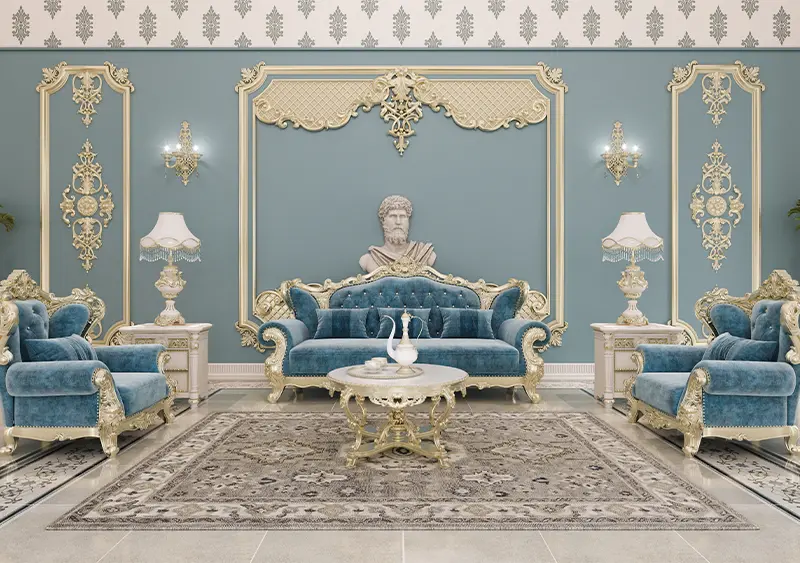How 3D Furniture Modeling Drives Business Growth
Learn how 3D furniture modeling enhances efficiency and drives business growth.

6 MIN READ
December 12, 2024

Written By
Sasikumar Janakiraman
This article highlights real-world success stories where 3D modeling service has helped businesses create better products, faster, while cutting costs and improving customer trust.
What are 3D Furniture Modeling Services?
3D furniture modeling services create digital, lifelike versions of furniture pieces, designed with precision using specialized software. These models replicate every detail, from dimensions and textures to colors and finishes, making them highly accurate representations of real-world furniture.
- Realistic Visuals: The models are almost indistinguishable from physical products, helping businesses showcase their designs to stakeholders and clients effectively.
- Customization Options: Enables tailored designs by adjusting dimensions, materials, or finishes in a matter of clicks.
- Compatibility: Integrates seamlessly with AR, VR, and e-commerce platforms, enhancing product presentations.
Business Benefits of 3D Furniture Modeling
3D furniture modeling has revolutionized how businesses in the furniture industry design, produce, and sell their products. By offering lifelike digital models, this technology simplifies complex processes, saves costs, and enhances customer experiences. Let’s explore the key benefits it brings to the table.

-
1. Realistic Product Previews
- 3D models allow businesses to showcase their furniture designs in precise detail.
- Customers see how the product looks with accurate textures, colors, and dimensions.
- Retailers can replace flat images with interactive 3D views, creating a more immersive experience.
-
2. Reduced Prototyping Costs
- Building physical prototypes can drain time and resources.
- 3D modeling eliminates the need for multiple samples by testing designs digitally.
- Businesses save money on materials and minimize waste during the design process.
-
3. Faster Design Approvals
- Design iterations and approvals move much quicker with digital models.
- Changes can be made in real-time, speeding up decision-making.
- Brands get their products to market faster, giving them an edge over competitors.
-
4. Better Collaboration Across Teams
- 3D models make communication between designers, manufacturers, and marketers seamless.
- Everyone works from the same detailed visuals, reducing misunderstandings.
- The production process becomes smoother, leading to fewer errors.
-
5. Enhanced Online Shopping Experiences
- For furniture brands selling online, 3D modeling adds an interactive layer to their e-commerce platforms.
- Customers can view furniture from every angle, boosting confidence in their purchase.
- Options like changing finishes or upholstery are instantly visible, personalizing the shopping experience.
-
6. Support for AR and VR Applications
- As technology advances, augmented and
virtual reality are becoming key tools in the industry.
- AR lets customers visualize furniture in their rooms using just a smartphone.
- VR offers immersive showroom experiences without leaving home, elevating the brand's appeal.
-
7. Fewer Product Returns
- Accurate 3D visuals set the right
expectations for customers, reducing dissatisfaction.
- When buyers know exactly what they’re getting, returns drop significantly.
- This not only saves costs but also strengthens customer trust in the brand.
-
8. Improved Brand Presentation
- Using 3D modeling reflects a modern, forward-thinking approach.
- It positions businesses as industry leaders who embrace innovation.
- High-quality visuals enhance marketing materials, from catalogs to ads.
Real-World Impact: How 3D Furniture Modeling is Shaping Businesses
Let’s have a look at how top companies are making use of 3D furniture modeling services to improve efficiency, reduce costs, and stay ahead in the competitive furniture market. These real-world examples show how businesses are upgrading their operations and customer experiences with the help of 3D technology.
Case 1: Leading U.S. Furniture Manufacturer
This major furniture manufacturer faced ongoing challenges with traditional design methods. Those long lead times, high prototyping costs, and frequent design miscommunications. It wasn’t just affecting their bottom line, but also slowing down their ability to keep up with market demand.
The Shift: By implementing 3D furniture modeling, the company was able to quickly generate digital prototypes and showcase designs to stakeholders with unmatched accuracy. The ability to adjust designs in real time and present high-quality renders sped up approvals and reduced costly errors in production.
The Results: Not only did the company cut down on physical prototyping costs, but they also decreased their time-to-market. As a result, they were able to launch new products faster and more efficiently, ultimately improving their profitability and market position.
Case 2: High-End Interior Design Firm
An upscale 3D modeling firm specializing in interior design for luxury residential and commercial projects faced a unique challenge, helping clients visualize custom furniture in their spaces before making a decision. Traditional methods, such as fabric samples and sketches, fell short of capturing the sophistication and precision their clients expected.
The Shift: Adopting 3D modeling allowed the firm to create incredibly detailed, photorealistic models of their furniture. Clients could now see exactly how pieces would look in their space, experiment with different materials, and make changes instantly.
The Results: The firm drastically reduced the back-and-forth with clients, speeding up the approval process and reducing costly revisions. Clients appreciated the transparency and accuracy, leading to more repeat business and stronger referrals.
Case 3: E-Commerce Furniture Brand
An emerging e-commerce furniture brand was struggling to convert online visitors into customers. Their product images and descriptions didn’t fully capture the quality and details of their offerings, leading to lower conversion rates and higher product returns.
The Shift: The brand incorporated interactive 3D models into their product pages, giving customers the ability to view and rotate items from every angle. They also added customization options, letting customers choose different finishes or materials and see the changes in real time.
The Results: The interactive experience resulted in a significant boost in online sales. Customers were able to visualize the furniture in much more detail, leading to more confident purchases and fewer returns. The brand also saw a marked increase in customer satisfaction and engagement.
Partner with us for 3D furniture modeling services with us and witness your Business growth!
Adoption Challenges and Mitigation Strategies
Let’s understand some of the common hurdles and how to overcome them.
-
1. High Initial Investment
- One of the first concerns many businesses face when considering 3D modeling is the upfront cost. The technology,
software, and skilled personnel required can seem like a significant investment.
- Mitigation Strategy:
- While the initial investment can be substantial, the long-term savings from reduced prototyping costs and improved design efficiency often outweigh the expenses. Start by piloting the technology on a small scale or with a single product line to assess its value. As you see the benefits, you can gradually expand its use across your business.
-
2. Technical Complexity
- 3D modeling requires specialized skills and expertise that not all in-house teams may have. Without the right
knowledge, businesses can struggle to get the most out of the technology.
- Mitigation Strategy:
- Invest in training for your team or collaborate with external experts who specialize in 3D modeling. Many software providers offer tutorials and support for getting started. You can also partner with third-party 3D modeling service providers who bring in the necessary technical know-how, allowing your team to focus on other aspects of your business.
-
3. Integration with Existing Systems
- For established businesses, integrating new technology into legacy systems can be challenging. The last thing
you want is to disrupt your existing workflow or production line.
- Mitigation Strategy:
- Choose a 3D modeling solution that’s compatible with your current design and manufacturing processes. Most modern software options allow seamless integration with CAD, ERP, and other industry-standard systems. Take the time to test the software in real-world scenarios before fully committing to it.
-
4. Resistance to Change
- As with any new technology, some employees may be resistant to change, especially if they’re comfortable
with traditional design methods. Convincing your team to embrace 3D modeling may take time and patience.
- Mitigation Strategy:
- Focus on the benefits. Demonstrate how 3D modeling can make their jobs easier by reducing manual tasks, improving accuracy, and speeding up the design process. Offering training sessions and showing successful case studies within your industry can also help ease the transition.
-
5. Maintaining Accuracy and Quality
- 3D models need to be highly accurate to ensure they translate well into real-world products. Any discrepancies
between the model and the final product can lead to costly mistakes and wasted resources.
- Mitigation Strategy:
- Invest time in refining your models and ensuring high levels of detail in the initial stages. Work closely with your design and production teams to ensure that models are reviewed and approved before any physical production takes place. Regular feedback loops and quality checks will help maintain accuracy.
Final Thoughts
3D furniture modeling services are a powerful tool for businesses in the furniture industry, speeding up design processes, cutting costs, and improving customer satisfaction. Though challenges exist in adopting this technology, the long-term advantages are undeniable. For any business aiming to stay ahead, embracing 3D modeling is not just an option, but a necessity.
Ready to transform your product lineup? Outsource your 3D modeling services to us and watch your ideas come to life in stunning detail!
About the writer :
Sasikumar Janakiraman, as the Creative Director at Zealous Services, brings a unique mix of creativity and technical ... skill. He’s passionate about 2D and 3D design, leading teams to create stunning 3D models and visualizations. Sasikumar loves working closely with clients, making sure their ideas come to life in the best possible way. His goal? To make design feel simple and exciting.
Read MoreFrequently Asked Questions (FAQ)
How long does it take to create a 3D model for furniture?
The time it takes to create a 3D model depends on the complexity of the design. Simple pieces may take a few days, while more intricate designs or custom furniture can take several weeks. Factors like the level of detail, materials, and any customizations will impact the timeline.
What software is commonly used for 3D furniture modeling?
Popular software for 3D furniture modeling includes AutoCAD, SketchUp, Blender, and Rhino. Each offers different features, so the best choice depends on the specific needs of the business and the level of detail required for the models.
Can 3D furniture models be used for mass production?
Yes, once a 3D model is finalized, it can be used to guide mass production processes. The detailed models help ensure consistency and accuracy in manufacturing, reducing the chances of errors during production.
Is 3D modeling suitable for all types of furniture businesses?
Yes, whether you are a small-scale manufacturer, an interior designer, or a large retailer, 3D modeling services can benefit businesses of all sizes. It’s especially valuable for companies that want to improve design accuracy, reduce production costs, and provide better customer experiences.
How does 3D furniture modeling improve the customer buying experience?
3D models allow customers to interact with products in a more detailed and immersive way. They can see furniture from multiple angles, customize it with different materials or colors, and even visualize it in their own spaces using AR technology — leading to higher confidence in their purchase decisions.
How can 3D furniture modeling services be integrated with my existing business workflow?
Most 3D modeling software integrates smoothly with CAD systems and other production tools, allowing for a seamless transition without disrupting your current operations.